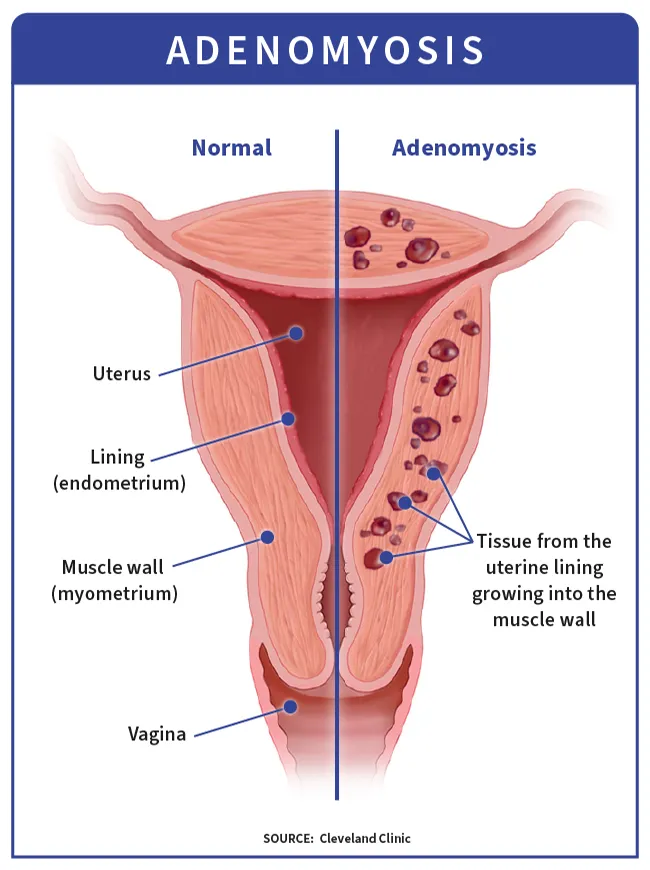What Is Adenomyosis?
When you have adenomyosis, tissue from the inner lining of your uterus (the endometrium) grows into the muscle wall of your uterus (the myometrium). This misplaced tissue can cause trouble in the years before menopause because it continues to respond to the monthly hormones that cause periods. When your uterine lining thickens, breaks down, and bleeds, this tissue does too. As a result, your uterus may double or triple in size and you may have more painful, heavy periods.
Though adenomyosis doesn't threaten your life, it can be disruptive and distressing.
Adenomyosis vs. endometriosis
Adenomyosis and endometriosis are both conditions in which the kind of tissue that normally lines your uterus ends up growing elsewhere. The difference lies in where the tissue grows. In adenomyosis, it grows in the muscle wall of the uterus. In endometriosis, it grows outside the uterus, in places like your ovaries and fallopian tubes.
Both conditions can be painful. Adenomyosis is more likely to cause heavy periods.

Adenomyosis Symptoms
While about a third of people with adenomyosis have no symptoms, the disease can cause:
- Heavy, prolonged menstrual bleeding
- Severe menstrual cramps
- Abdominal pressure and bloating
- Painful sex
- Trouble getting pregnant (infertility)
Adenomyosis Causes
Doctors don't know what causes this condition, but they have some theories:
Invasive cells. Cells from your uterine lining might invade the muscle wall. If you have surgery on your uterus, such as a C-section, that might provide an opening for cells to spread.
Developmental origins. Some cells might grow in the wrong place during fetal development, meaning you're born with the misplaced tissue already in the muscle wall.
Inflammation after childbirth. The uterine lining can get inflamed after childbirth, which might cause a breakdown in the barrier between the lining and the muscle wall.
Stem cells. Bone marrow stem cells, which are cells that have the ability to develop into other cell types, may play a role in the development of the abnormal tissue, some researchers believe.
Does Adenomyosis Cause Infertility?
Studies suggest it can be harder to get pregnant if you have adenomyosis. You also may have a higher risk of miscarriage. The reasons for the links aren't clear, but the disease may lower pregnancy chances by:
- Changing the shape of your uterine cavity
- Causing inflammation
- Causing unusual uterine contractions
- Changing hormones important to pregnancy
Many of the findings are from studies of people going through in vitro fertilization (IVF) treatment. Fertility doctors are studying ways to improve pregnancy and birth rates in patients with adenomyosis.
Adenomyosis Risk Factors
If you have a uterus, adenomyosis is most likely to develop in your 40s and 50s. But doctors are increasingly finding the condition in teens and younger adults assigned female at birth. About 2%-5% of teens with very heavy periods have adenomyosis. Your risk is higher if you:
- Have given birth at least once
- Have had surgery on your uterus, such as a C-section, fibroid removal, or dilatation and curettage (D&C)
- Have endometriosis
Diagnosing Adenomyosis
Adenomyosis can be hard to diagnose because the symptoms are similar to those of other conditions, including endometriosis and uterine fibroids. To find the cause of your symptoms, the doctor may suggest:
Pelvic exam. The doctor may find that your uterus is enlarged, soft, and painful to the touch if you have adenomyosis.
Ultrasound. This test can allow a doctor to see the uterus, its lining, and its muscular wall. Though ultrasound cannot definitively diagnose adenomyosis, it can help rule out other conditions.
Sonohysterography. In this test, saline solution is injected through a tiny tube into the uterus as an ultrasound is given.
MRI . This can show if your uterus is enlarged and thickened in some areas.
Endometrial biopsy. By taking some tissue from your uterine lining, the doctor can rule out some other conditions.
If you have a hysterectomy (the removal of your uterus), doctors can examine the tissue to confirm adenomyosis.
Adenomyosis Complications
Left untreated, adenomyosis can lead to:
- Chronic pelvic and abdominal pain
- Chronic iron-deficiency anemia, caused by prolonged heavy periods, leading to symptoms such as fatigue and dizziness
- Trouble getting pregnant (infertility)
- Miscarriage
Can Adenomyosis Be Cured?
The only sure cure for the condition is the removal of your uterus, a hysterectomy. That might be a reasonable choice if your symptoms are severe, you don't want to get pregnant, and other remedies haven't worked. But symptoms often end on their own at menopause, when menstrual periods end. Your uterus may remain enlarged even after menopause.
Adenomyosis Treatment
If a hysterectomy doesn't make sense for you, other treatments can ease symptoms until you reach menopause.
These include:
Painkillers. You might use over-the-counter or prescription nonsteroidal anti-inflammatory drugs (NSAIDs), such as ibuprofen or naproxen, to relieve pain and cramps. Your doctor might suggest you start taking them 1-2 days before your period begins and through the first few days of bleeding.
Hormone therapy. Certain hormonal medications, including hormone-releasing intrauterine devices (IUDs), birth control pills, patches, and injections, can help with bleeding and pain. Some will stop periods, offering extra symptom relief.
Nonhormonal medication. Medications such as tranexamic acid can reduce menstrual bleeding.
Adenomyomectomy. This is surgery to remove tissue from your uterine muscle. It's similar to a myomectomy, which removes uterine fibroids.
Uterine artery embolization. Commonly used to shrink fibroids, this procedure involves using tiny particles to block the blood vessels that supply blood to the unwanted tissue. The particles are guided through a tiny tube inserted by a radiologist into an artery. With the blood supply cut off, the adenomyosis shrinks.
Endometrial ablation. This procedure destroys the lining of the uterus, using heat. It can reduce menstrual bleeding but doesn't address the underlying issue.
Hysterectomy for adenomyosis
If you decide to have a hysterectomy, the surgeon may remove only the uterus, or the uterus and cervix (the canal that connects your uterus and vagina). There's no need to remove your ovaries and fallopian tubes. Depending on how enlarged your uterus is and other factors, the surgery might be done:
- Abdominally, with a large cut on your lower abdomen
- Laparoscopically, with a few smaller cuts
- Vaginally, with the uterus removed through the vagina
Living With Adenomyosis
In addition to treatments offered by your doctor, you might try soaking in warm baths or putting heating pads on your belly when you have cramps.
You should check in with your doctor if you have:
- Extremely heavy periods
- Severely painful cramps
- Pain during sex
- Feelings of heaviness or fullness in your abdomen
Takeaways
If you have heavy, painful periods, adenomyosis is a possible cause. The root problem is misplaced tissue growing in your uterine wall. Treatments can help, and the symptoms usually go away after menopause.
Adenomyosis FAQs
What makes adenomyosis worse?
Adenomyosis can get worse with age, until you reach menopause. A reason may be that the condition depends on estrogen and older women have been exposed to the hormone for a longer time than younger women have.
Does adenomyosis cause weight gain?
The condition doesn't cause weight gain, but some treatments might. The hormone progestin, used in some IUDs and birth control pills used to treat adenomyosis, is linked to weight gain. Also, the condition causes bloating, which might make you feel heavier. Some people say their enlarged uterus makes them look pregnant.

